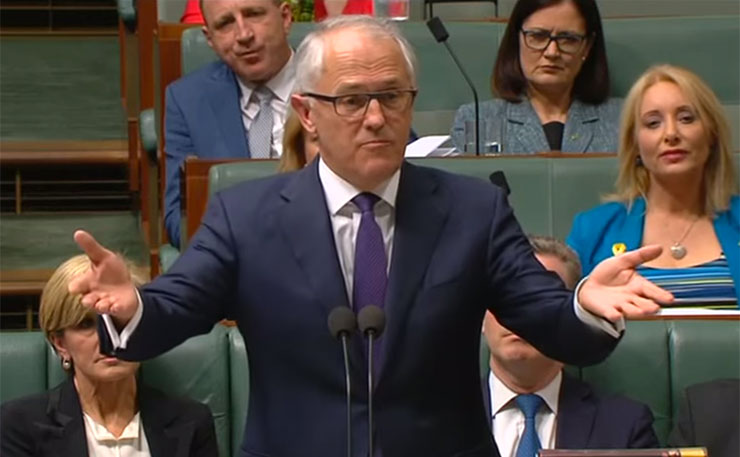Channelling the recent ghost of Tony Abbott when he announced the emission reduction targets Australia will adopt for the next two decades, our new Prime Minister Malcolm Turnbull appeared on a national news broadcast last night peddling lies and obfuscation about Australia’s contribution to curbing climate change.
In a broad ranging interview with journalist Leigh Sales on ABC’s 7.30, Turnbull insisted that “what’s good about the emissions reduction fund and other mechanisms the government has in place… is they’re working”.
That’s a lie, and as a long-running critic of the policy Turnbull knows that.
The truth is that the policy the Abbott Government developed in the wake of Turnbull’s ousting as Opposition Leader in 2009 over this very issue, the so-called ‘Direct Action’ policy, has always been plagued with questions over its glaring inadequacies.
Unhelpfully, the Abbott government simply refused to acknowledge and address those questions, and it’s a tactic Turnbull is now imitating with gusto.
The core of the government’s Direct Action policy is the $2.5 billion Emissions Reduction Fund, which is essentially a huge grab-bag of your cash the government hands over to large polluting companies, in order to entice them to pollute a little less.
Under the policy, companies compete in ‘reverse auctions’ by applying for government funding to allow them to abate emissions their business activities would otherwise create.
Under this policy, and in contrast to the Gillard government’s, taxpayers foot the bill rather than the big polluters. At this stage there’s really no guarantee our money’s buying us anything.
The most gaping wound in Direct Action’s credibility is that the government is yet to incorporate any mechanism to prevent those companies which choose not to compete in ‘reverse auctions’ from simply ignoring the policy and increasing their emissions unabashed.
It’s a flaw so deep that an analysis by RepuTex Market Analytics earlier this year judged the policy “untenable” unless strict baselines were incorporated to prevent those companies that don’t participate from embarking on a carbon binge.
“None of Australia’s top 20 emitting facilities are currently expected to incur any liability under the scheme,” the analysis said, “despite almost all being forecast to grow their emissions over the next 10 years”.
“This means the largest generators [of carbon emissions]such as [power stations]Loy Yang A and B, Hazelwood, Bayswater and Yallourn are expected to avoid exceeding their sectoral baseline under the scheme.”
As Turnbull noted so sagely last night, “the objective of climate policy is to reduce your emissions”. You would think the country’s largest emitters might need to reduce their emissions in order to do that.
Still, Turnbull maintained that “what [Environment Minister Greg Hunt] has designed is a set of measures that we are confident will be able to reduce our emissions at the rate we’re proposing, [and]at a very manageable cost”.
Even if that were true, the rate of emissions reduction Australia has committed to is woefully inadequate. When measured against a host of comparable economies — like the European Union, the United States, New Zealand, Canada and Japan — Australia is running at about 65 per cent of the level of ambition on a year-on-year reduction basis out to 2030.
In other words, we’re not doing our bit. We’re doing less than two-thirds of our bit, and we’re doing that as one of the highest polluting nations on earth on a per capita basis.
Without serious improvements to the policy itself — and there are plenty of options in that regard — that’s unlikely to change, and already high costs are likely to climb.
In the first round of reverse auctions, the government blew a quarter of the $2.5 billion budget allocated to meet our targets out to 2020, but achieved just 15 per cent of the abatement needed to reach the five per cent reduction target for that year.
The government has made much of the supposedly efficient $14 dollar per tonne the taxpayer paid for 47 million tonnes of carbon abatement purchased in the first reverse auction. But there’s a consensus among analysts that the price per tonne will almost certainly increase after the easy projects are picked off.
And if Australia does manage to achieve its five per cent target for 2020, based on 2000 level emissions, it will likely be due to external factors like carry-overs from previous reductions achieved under efforts associated with the Kyoto Protocol, and a decline in emissions from an ailing manufacturing industry.
In addition, there is widespread cynicism over how the Emissions Reduction Fund could remain affordable to meet the new 2030 climate targets – a 26 per cent reduction by 2030, based on the unusually high level of pollution Australia notched up in 2005.
Tellingly, since the carbon tax was scrapped a downward trend in carbon emissions has been reversed, and pollution is once again climbing. The policy is not working, and Turnbull should be honest about that with the Australian people.
He put it best before he was Prime Minister, in 2011, when he emphasised the need for “a long-term technique of cutting carbon emissions… in a very substantial way to the levels that the scientists are telling us we need to do by mid-century to avoid dangerous climate change”.
“A Direct Action policy where the government, where industry, was able to freely pollute, if you like, and the government was just spending more and more taxpayers’ money to offset it, that would become a very expensive charge on the budget in the years ahead,” Turnbull said before he climbed the greasy pole.
Donate To New Matilda
New Matilda is a small, independent media outlet. We survive through reader contributions, and never losing a lawsuit. If you got something from this article, giving something back helps us to continue speaking truth to power. Every little bit counts.




